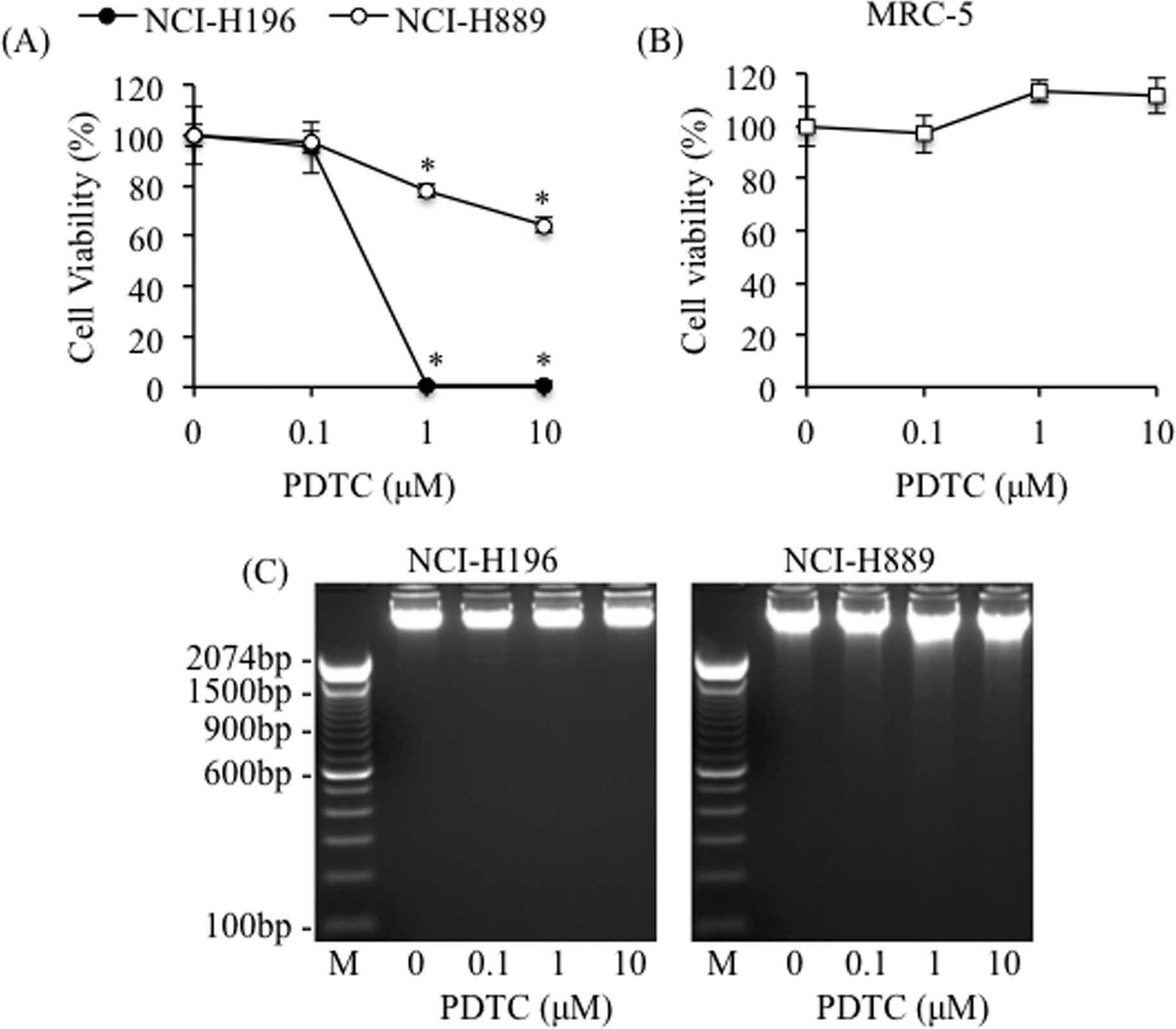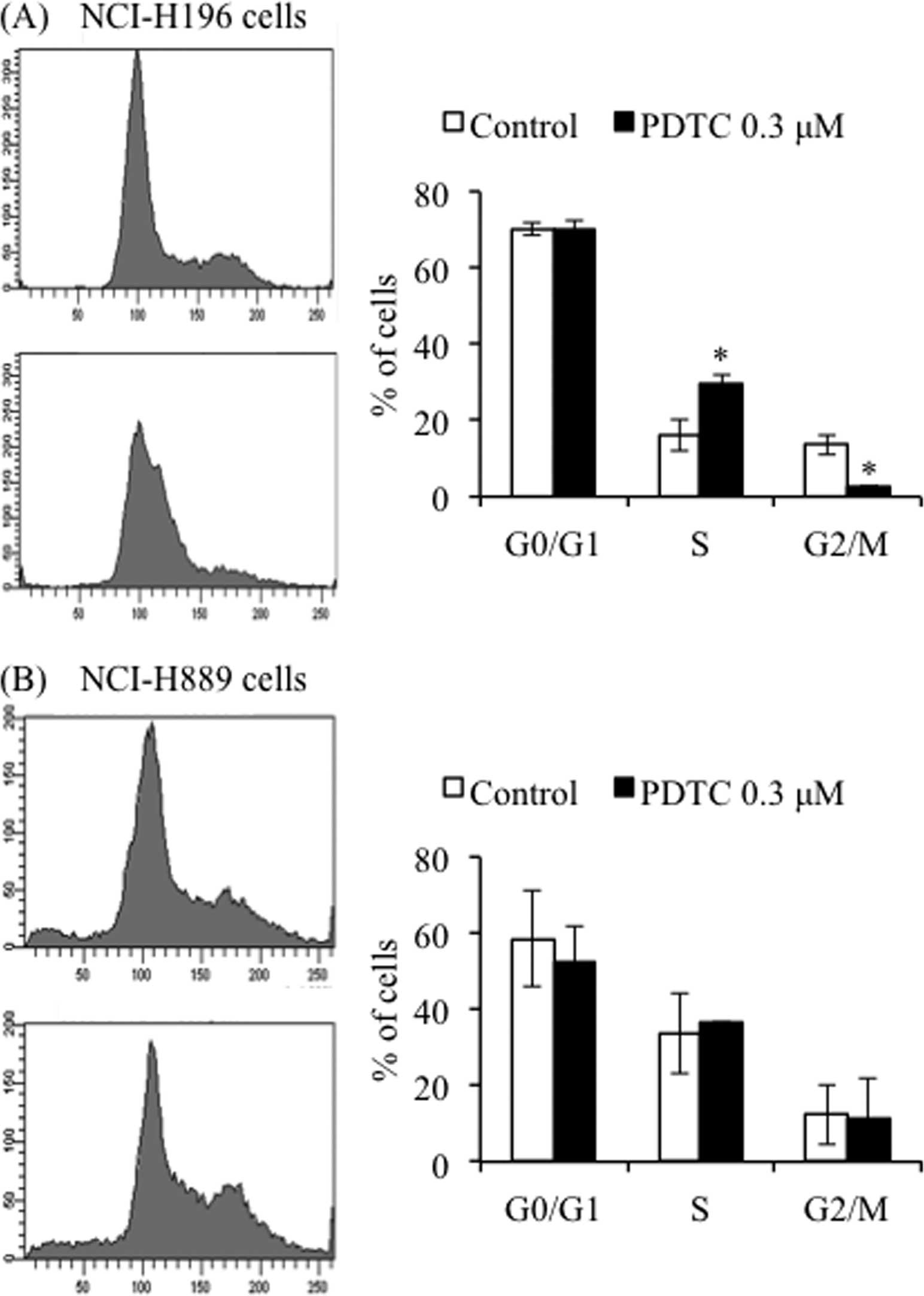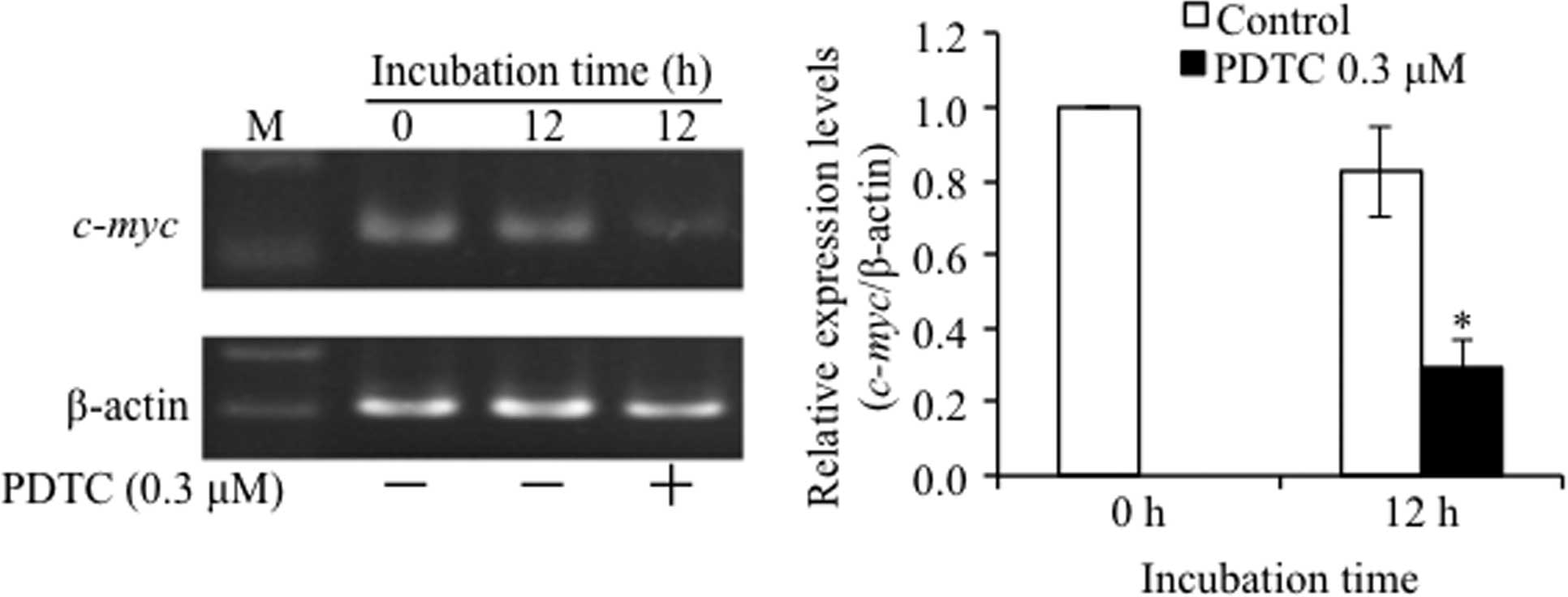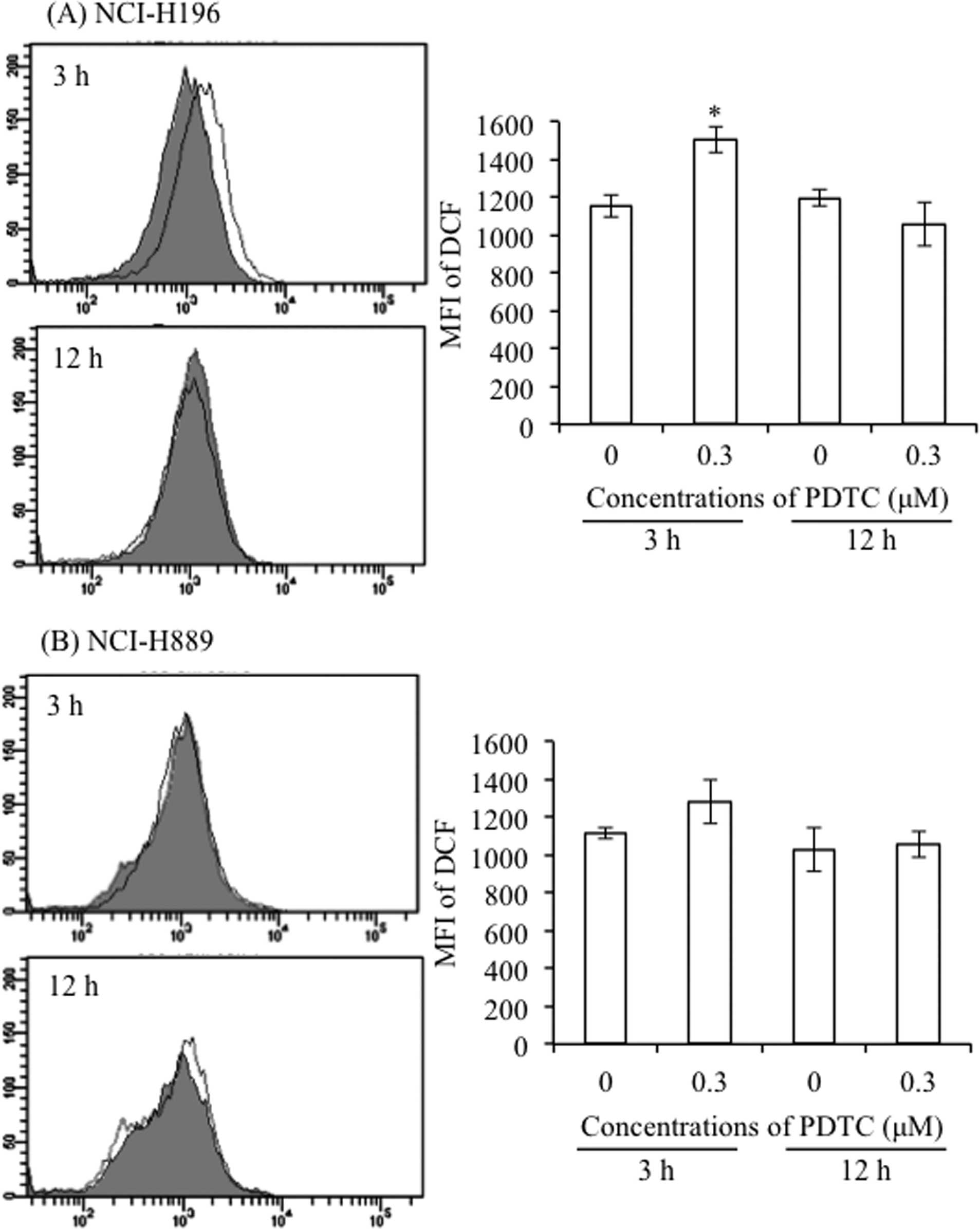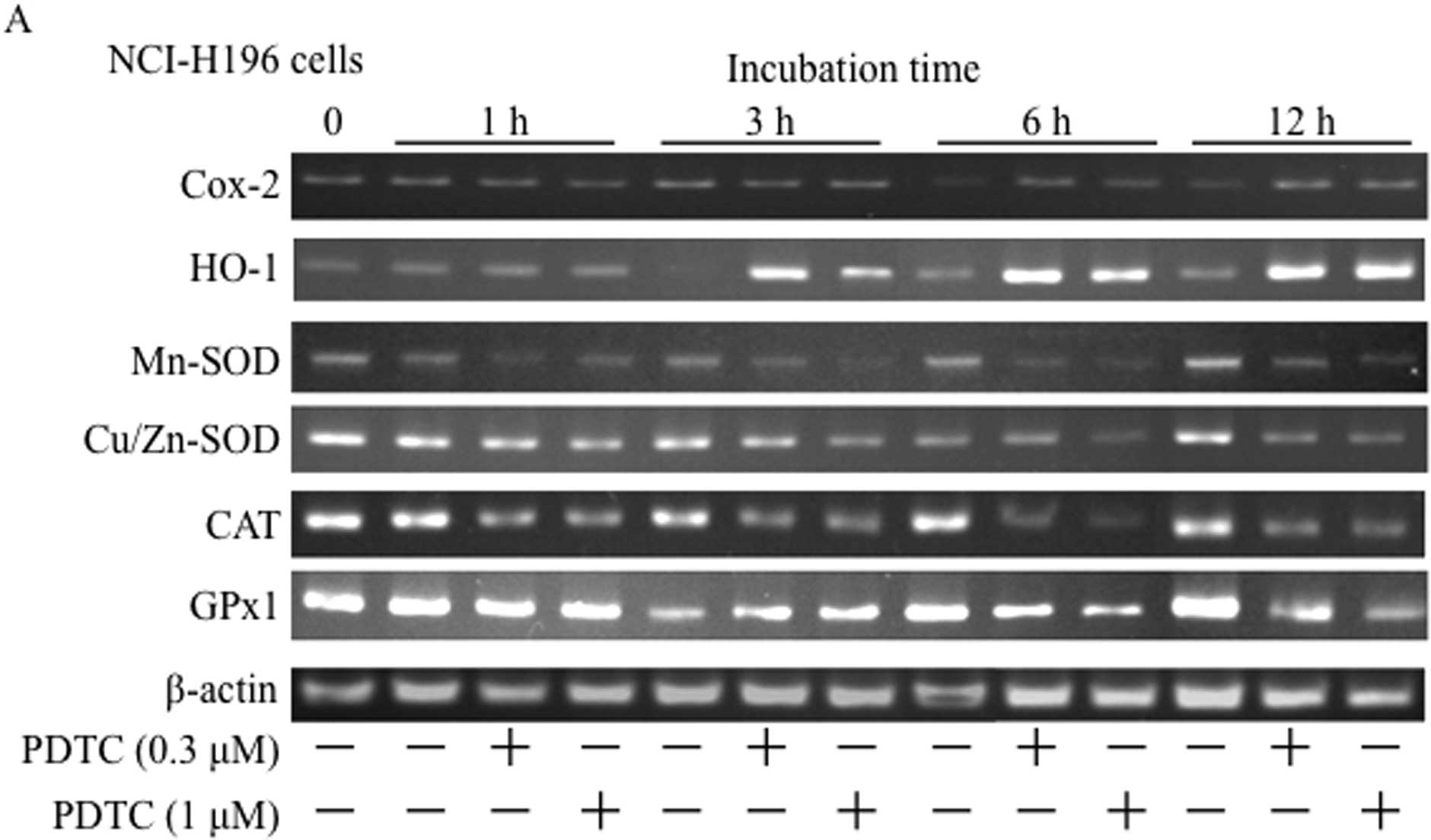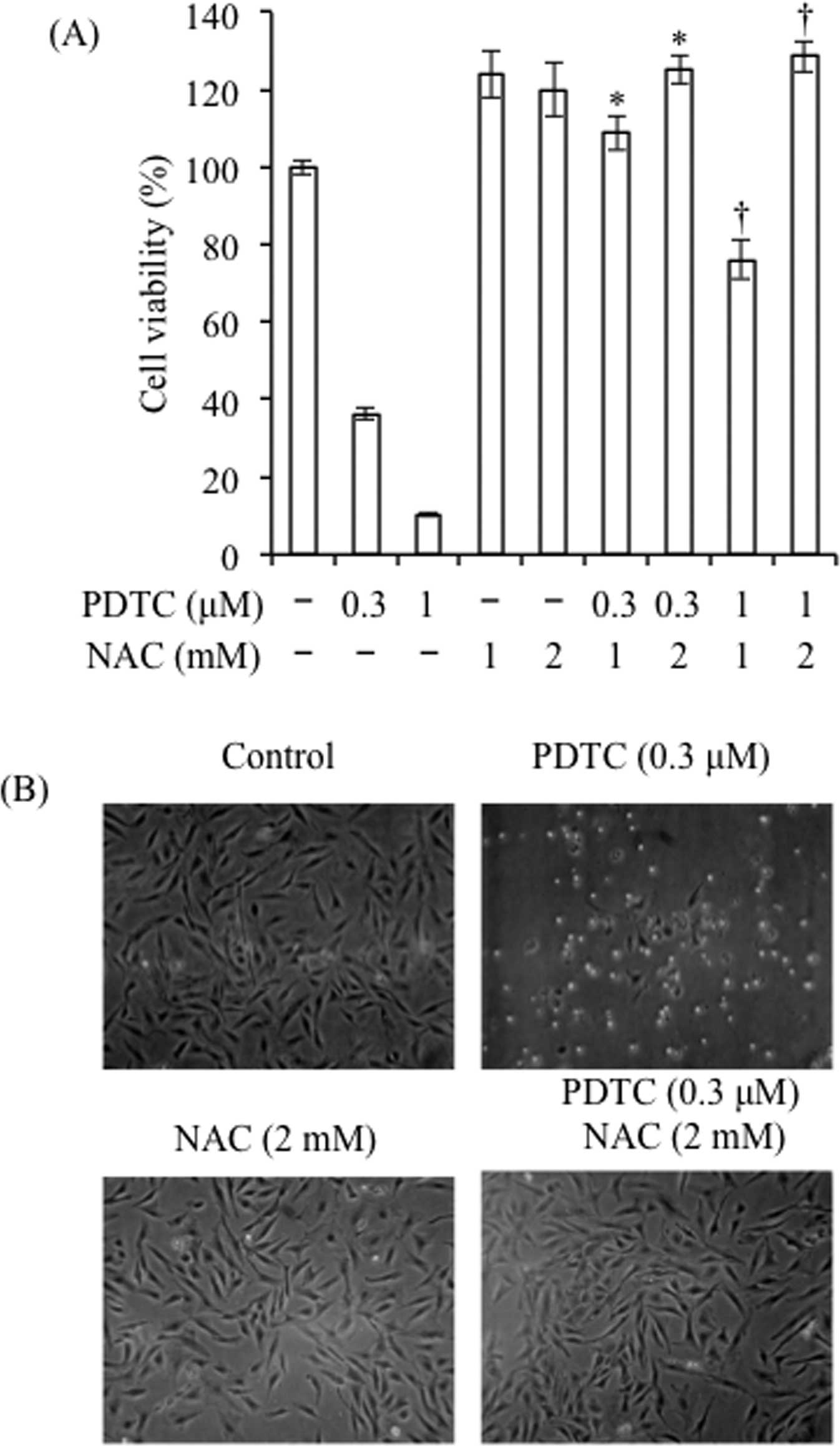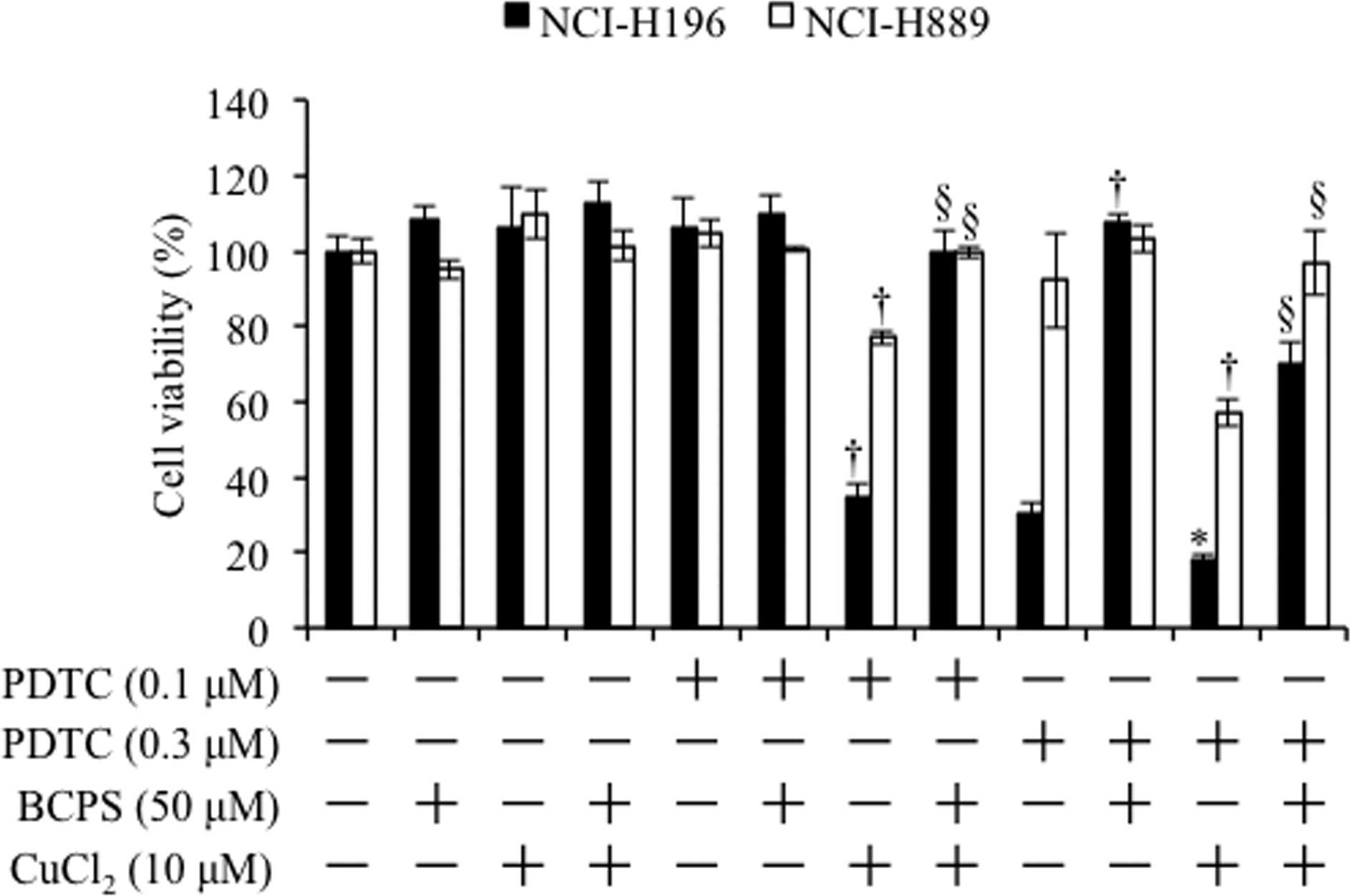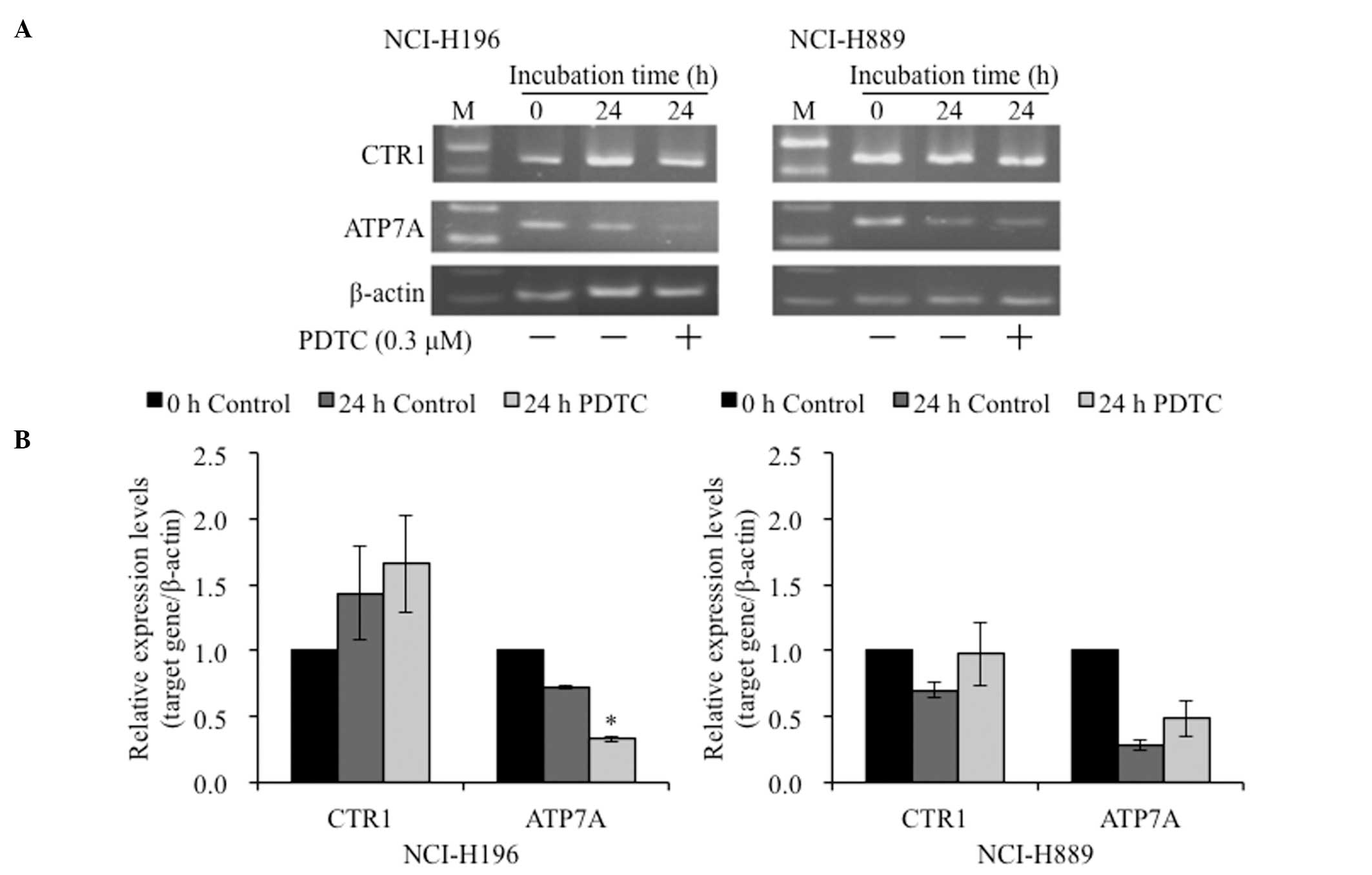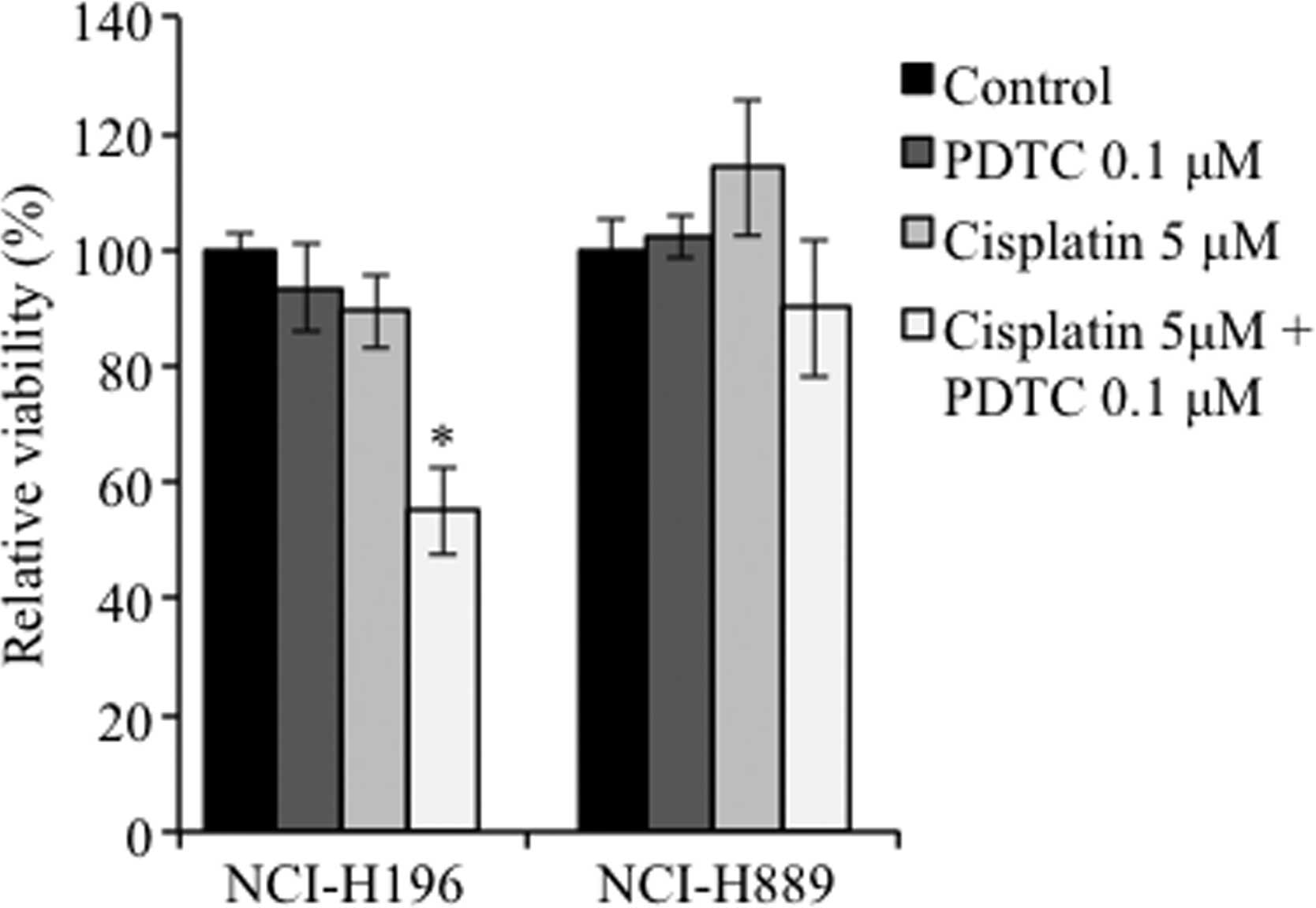Cytotoxic effects of pyrrolidine dithiocarbamate in small-cell lung cancer cells, alone and in combination with cisplatin
- Authors:
- Published online on: July 28, 2014 https://doi.org/10.3892/ijo.2014.2564
- Pages: 1749-1759
Abstract
Introduction
Lung cancer has been and remains one of the most common malignancy in the world with an estimated 1.6 million new cases per annum (1). Small-cell lung cancer (SCLC), which constitutes between 10 and 15% of all lung neoplasm and is different from non-small-cell lung cancer (NSCLC) types in that it has neuroendocrine features, grows more rapidly, spreads earlier and has a lower cure rate (1,2). Furthermore, SCLC metastasizes rapidly to distant sites within the body and is most often discovered after it has spread extensively (1,3).
Whilst SCLC is initially sensitive to chemotherapy and radiotherapy, relapse is almost inevitable and the efficacy of treatment beyond first-line therapy diminishes as it becomes increasingly resistant to treatment (1–3). Although continuous efforts to improve clinical outcomes in patients with SCLC by progressing clinical trials with novel promising drugs are ongoing, platinum (such as cisplatin)-etoposide doublets still represent the gold standard of a first-line therapy (1). Furthermore, the 5-year survival rates have not improved significantly over the last 40 years and have currently plateaued, although advance in diagnosis and treatment have resulted in improved survival of other solid-tumor malignancies (1). Therefore, there is an obvious need to develop new therapeutic strategies for SCLC.
Pyrrolidine dithiocarbamate (PDTC), a thiol compound derived from dithiocarbamates, was initially described as an antioxidant agent and reported to induce cytotoxicity in some tumor cell lines (4,5). On the other hand, PDTC has been described to act as a pro-oxidant agent (6–9). In fact, its pro-oxidant activity has been demonstrated to induce growth inhibition and cell death in rat cortical astrocytes (6), a human pancreatic adenocarcinoma cell line, PaGa44 (10) and promyelocytic leukemic cell line, HL-60 (11), respectively. It should be noted that PDTC has been demonstrated to sensitize human cervical cancer line and metastatic renal cell carcinoma to cisplatin (12,13). As mentioned above, cisplatin-based regimens have become and remain the first-line treatment for SCLC from the 1980s (14,15). Therefore, we hypothesize that PDTC may be a promising candidate of adjunct therapeutic reagent for SCLC. However, the effect of PDTC in SCLC cell lines, alone or in combination with cisplatin, has not yet been investigated.
Increased intracellular Cu content has been associated with PDTC-mediated cytotoxicity due to its ionophore properties (6,9,11). Furthermore, the presence of CuCl2 has been demonstrated to potentiate the cytotoxic effects of PDTC in rat cortical astrocytes and HL-60 cells (6,11). Intracellular Cu homeostasis is well known to be maintained by Cu transporters including copper-transporting P-type adenosine triphosphatase (ATP7A) responsible for Cu efflux, and copper transporter 1 (CTR1) responsible for Cu uptake (16). Moreover, ATP7A has been reportedly associated with platinum drug resistance in various types of solid tumors (16–18). It is especially noteworthy that ATP7A plays a critical role in cisplatin-resistance of NSCLC, and is a negative prognostic factor of NSCLC patients treated with platinum-based chemotherapy (19–21). However, to our knowledge, little is known about the expression of Cu transporters in SCLC cell lines as well as the impact of PDTC on their expression.
In the present study, we investigated first the cytocidal effects of PDTC on SCLC cell lines in view of growth inhibition, cell cycle arrest and apoptosis induction. We further evaluated whether oxidative stress is involved in the cytocidal effects by determining alterations in intracellular reactive oxygen species (ROS) level along with expression levels of oxidative-related genes. At the same time, the effect N-acetyl-l- cysteine (NAC), a free radical scavenger, on PDTC-mediated cytotoxicity was also evaluated. We further investigated the cytocidal effect of PDTC in combination with CuCl2 in the presence or absence of bathocuproine disulfonate (BCPS), a non-permeable copper-specific chelator, in order to verify whether Cu is involved in the cytocidal effect. Importantly, we investigated for the first time the effect of PDTC on the expression levels of copper transporters such as ATP7A and CTR1, and further evaluated the effects of cisplatin in combination with non-toxic dose of PDTC on SCLC cell lines.
Materials and methods
Materials
PDTC, RPMI-1640 medium, CuCl2, NAC, and ISOGEN (Wako Pure Chemical Industry, Osaka, Japan); fetal bovine serum (FBS) (Nichirei Biosciences, Tokyo, Japan); agarose X (Nippon Gene, Tokyo, Japan); dichlorofluorescin diacetate (DCFH-DA) (Invitrogen, Carlsbad, CA, USA); propidium iodide (PI), ribonuclease A (RNaseA), 2,3-bis(2-methoxy-4-nitro-5-sulfophenyl)-5-[(phenylamino) carbony]-2H-tetrazolium hydroxide (XTT), BCPS and cisplatin (Sigma-Aldrich, St. Louis, MO, USA) were purchased from indicated suppliers.
Cell culture and treatment
Human SCLC cell lines (NCI-H196 and NCI-H889) and normal human embryonal lung fibroblast MRC-5 cells were obtained from the American Type Culture Collection (ATCC, Manassas, VA, USA). SCLC cell lines and MRC-5 cells were cultured in RPMI-1640 medium and Eagle’s minimum essential medium (MEM), respectively, supplemented with 10% heat-inactivated FBS, 100 U/ml of penicillin and 100 μg/ml of streptomycin at 37°C in a humidified atmosphere (5% CO2 in air). Cells were treated with indicated concentrations of PDTC for the indicated time-points. In order to investigate whether oxidative stress is involved in PDTC-induced cytotoxicity, cells were treated with 0.3 or 1 μM PDTC in the presence or absence of 1 or 2 mM NAC for 24 h. Moreover, in order to clarify whether copper ions are implicated in the PDTC-induced cytotoxicity, cells were treated with CuCl2 (10 μM) and BCPS (50 μM) (a non-permeable copper-specific chelator), alone or in combination, for 3 h prior to treatment with 0.1 and 0.3 μM PDTC in the presence or absence of these reagents. Cells were also treated with 5 μM cisplatin in the presence or absence of 0.1 μM PDTC for 24 h to investigate whether PDTC sensitize SCLC cell lines to cisplatin. Cell viability was measured by the XTT assay as described previously (22). IC50 value of PDTC was ~0.3 μM calculated from the cell proliferation inhibition curve of NCI-H196 cells after 24-h treatment.
DNA fragmentation analysis
DNA fragmentation analysis was carried out according to a method described previously (23). Briefly, DNA samples [~20 μg DNA/20 μl TE buffer (10 mM Tris-HCl, pH 7.8, 1 mM EDTA)] and a Tracklt™ 100 bp DNA Ladder (Invitrogen) as a DNA size marker were electrophoresed, respectively, on a 2% agarose X gel, and visualized by ethidium bromide staining, followed by viewing under UV Light Printgraph (ATTO Corp., Tokyo, Japan).
Cell cycle analysis
After treatment with the IC50 value of PDTC at 0.3 μM for 24 h, cell cycle analysis was performed using a FACSCanto flow cytometer (Becton-Dickinson, CA, USA) according to methods reported previously with modifications (24,25). A total of 10,000 events were acquired and Diva software and ModFit LT™ Ver.3.0 (Verity Software House, ME, USA) were used to calculate the number of cells at each sub-G1, G0/G1, S and G2/M phase fraction.
Reverse transcription-polymerase chain reaction (RT-PCR) analysis
Total RNA isolation and complementary DNA were prepared according to methods described previously with modifications (23). Total RNA was extracted from cells using an RNA extraction kit, ISOGEN. Complementary DNA was synthesized from 1 μg of RNA using 100 pmol random primer and 50 U M-MLV RT in a total volume of 20 μl, according to the manufacturer’s instructions. PCR was performed according to the methods previously described (23) using a Takara Thermal Cycler MP (Takara Shuzo Co., Osaka, Japan). DNA sequences of PCR primers and optimal conditions for PCR are shown in Table I. PCR primers were purchased from Sigma-Aldrich (Hokkaido, Japan). PCR products and 100 bp DNA Ladder were electrophoresed on a 2% UltraPure™ agarose gel (Invitrogen), respectively, and visualized by ethidium bromide staining, followed by viewing under UV Light Printgraph. The relative expression levels of target gene/β-actin gene were calculated as the ratios against those at 0-time using ImageJ 1.46 m (Wayne Rasband, USA).
Measurement of intracellular ROS levels
Intracellular ROS levels were analyzed using DCFH-DA as a ROS-reactive fluorescence probe as described previously (24,26). In brief, after treatment with 0.3 μM PDTC for 3 or 12 h, cells (1×106 cells) were suspended in 1 ml of PBS with 5 mM DCFH-DA and incubated for 20 min at 37°C. Next, cells were washed with PBS twice, and resuspended in 500 μl of 2 μg/ml PI/PBS. The mean fluorescence intensity (MFI) of DCF green fluorescence from 3×104 cells were acquired for flow cytometry analysis using a FACSCanto flow cytometer and Diva software.
Statistical analysis
Data were analyzed using Student’s t-test and p<0.05 was considered as statistically significant.
Results
Cytocidal effects of PDTC on SCLC cell lines
After the treatment with various concentrations of PDTC (0.1, 1 and 10 μM) for 24 h, a significant decrease in cell viability was observed in a dose-dependent manner in NCI-H196 cells with IC50 value of 0.3 μM (Fig. 1A). On the other hand, although PDTC also exhibited dose-dependent cytotoxic activity against NCI-H889, the IC50 value of PDTC could not be calculated from its proliferation inhibition curve since >50% of cells survived even when treated with the highest concentration of PDTC (10 μM) (Fig. 1A), indicating NCI-H196 is more sensitive to the cytotoxicity of PDTC compared to NCI-H889. Moreover, no apparent cytotoxic activity was observed in normal human embryonal lung fibroblast MRC-5 when treated with the same range of PDTC concentrations even for 48 h (Fig. 1B). No DNA fragmentation was observed in either SCLC cell line, indicating no involvement of apoptosis induction in the PDTC-mediated cytotoxicity (Fig. 1C).
Effects of PDTC on cell cycle of SCLC cell lines
S phase arrest along with a significant decrease in the number of cells in G2/M phase was observed in NCI-H196 cells after treatment with the IC50 value of PDTC at 0.3 μM for 24 h (Fig. 2A). However, no apparent alterations of cell cycle were observed in NCI-H889 cells under the same treatment conditions (Fig. 2B). Furthermore, in agreement with the results presented in Fig. 1C, no significant accumulation of cells in sub-G1 phase was observed in the treated cells (Fig. 2).
Suppression of c-myc expression in PDTC-treated NCI-H196 cells
A large body of physiological evidence has shown that either upregulation or downregulation of c-myc activity has profound consequences on cell cycle progression (27,28). Therefore, the alteration of c-myc gene expression was evaluated in NCI-H196 cells after treatment with 0.3 μM of PDTC for 12 h. As shown in Fig. 3, the expression level of c-myc gene was significantly suppressed in PDTC-treated cells when compared to that in untreated cells. Furthermore, similar phenomena were not observed in NCI-H889 cells (data not shown).
Alteration of intracellular ROS levels in PDTC-treated SCLC cell lines
Since the pro-oxidant activity of PDTC has been described to induce growth inhibition and cell death in different types of cancer cells (10,11), intracellular ROS levels were evaluated in both SCLC cell lines after treatment with 0.3 μM of PDTC for 3 and 12 h. FACS analysis using DCFH-DA as a ROS-reactive fluorescence probe showed that a transient increase in the intracellular ROS levels was observed in NCI-H196 cells at 3-h post-treatment, followed by restoration to the control levels at 12-h post-treatment (Fig. 4A). On the other hand, a slight, but non-significant, increase in the accumulation of intracellular ROS was observed in NCI-H889 cells after treatment with PDTC for 3 h (Fig. 4B).
Expression profiles of oxidative stress-related mRNAs in PDTC-treated NCI-H196 cells
Since a transient increase in the intracellular ROS levels was observed in PDTC-treated NCI-H196 cells, expression profiles of oxidative stress-related gene mRNAs were evaluated in the cells after treatment with 0.3 and 1 μM of PDTC for 1, 3, 6 and 12 h, respectively. It should be noted that the expression profiles of these gene mRNAs in cells treated with 0.3 μM PDTC were very similar to those in cells treated with 1 μM PDTC. As shown in Fig. 5A and B, a significant increase in the expression level of Cox-2, which is known to play a central role in ROS production (29), was observed 6 h after treatment with PDTC, and the increase continued up to 12 h. Furthermore, the expression of HO-1, which is closely associated with oxidative stress mediated cellular damage (30,31), was significantly induced from as early as 3 h after the treatment with PDTC. In comparison to untreated cells, the level of HO-1 gene expression increased approximately 6- or 9-fold after 6- and 12-h treatment, respectively. Moreover, a significant decrease in the expression levels of Mn-SOD and Cu/Zn-SOD was observed 3 h after treatment with PDTC, and continued up to 12 h. A slight but significant downregulation in catalase expression was observed 1 h after treatment with PDTC, followed by a substantial decrease at 3- and 6-h post-treatment. Similar to the expression of other antioxidant enzymes, the expression levels of GPx1 were also significantly downregulated at 6- and 12-h post-treatment, respectively. Moreover, PDTC-mediated alterations in expression level of the above-mentioned oxidative-related genes were abolished by the addition of 2 mM NAC, a free radical scavenger (Fig. 5C). However, similar phenomena were not observed in NCI-H889 cells, except the behavior of HO-1 gene expression (data not shown).
Blocking of PDTC-induced cytotoxicity by NAC
To further verify whether oxidative stress is responsible for the cytotoxicity of PDTC against SCLC cell lines, we investigated the effects of NAC on the PDTC-induced cytotoxicity in NCI-H196 cells. As shown in Fig. 6A, dose-dependent cytotoxic effects of PDTC on NCI-H196 cells were reconfirmed by the reduction in cell viability. Furthermore, the cells treated with 0.3 μM PDTC for 24 h displayed apparent morphological changes such as shrinkage, spherical morphology, and detachment of the cells (Fig. 6B). In contrast, PDTC-induced reduction in cell viability and morphological changes were almost completely abrogated by the addition of 1 or 2 mM NAC (Fig. 6).
Inhibition of enhanced cytotoxicity of PDTC in combination with CuCl2 by BCPS
As shown in Fig. 7, no cytocidal effects was observed in either of the SCLC cell lines after treatment with 0.1 μM PDTC alone for 24 h, consistent with the results in Fig. 1. However, a significant decrease in cell viability was observed in both cells after treatment with 0.1 μM PDTC in combination with 10 μM CuCl2. Furthermore, a much stronger cytocidal effect against NCI-H196 cells was confirmed. Intriguingly, the addition of 50 μM BCPS, a non-permeable copper-specific chelator, completely abrogated the enhanced cytotoxicity of PDTC in combination with CuCl2. Moreover, after treatment 0.3 μM PDTC alone for 24 h, a significant decrease in the cell viability was observed in NCI-H196, but not in NCI-H889, reconfirming that NCI-H196 is more sensitive to the cytotoxicity of PDTC. Similarly, the addition of 50 μM BCPS completely abrogated 0.3 μM PDTC-mediated cytotoxicity in NCI-H196 cells. When both cells were treated with 0.3 μM PDTC combined with 10 μM CuCl2, the enhanced cytotoxicity was significantly abrogated by the addition of 50 μM BCPS. Moreover, no alteration in cell viability was observed in the cells when treated with BCPS and CuCl2, either alone or in combination.
Downregulation of expression levels of ATP7A in PDTC-treated NCI-H196 cells
It has been demonstrated that cellular oxidative stress induced by PDTC may be attributed to increased intracellular concentrations of Cu (9,32). Indeed, it has been clarified that treatment with a relatively high concentration of PDTC (10–100 μM) markedly increased an intracellular concentrations of Cu, and that the combination of PDTC (0.1–1 μM) with Cu (1 μM) also significantly increased the concentrations of intracellular Cu in parallel with an enhanced cytotoxicity in HL-60 cells and rat thymocytes, respectively (9,11). Therefore, the expression levels of ATP7A responsible for Cu efflux, and CTR1 responsible for Cu uptake were investigated in PDTC-treated SCLC cell lines. As shown in Fig. 8, in comparison to control at 24-h time-point, almost no alteration in the expression level of CTR1 was observed in the cells after treatment with 0.3 μM PDTC for 24 h, although there was a trend showing an increase in its expression level. On the other hand, the expression level of ATP7A significantly decreased by >50% in NCI-H196 cells, whereas displayed a slight, but not significant, increase in NCI-H889 cells. Interestingly, the expression level of two Cu transporters appeared to be affected by medium change, since notable differences in their expression levels were observed in control groups between 0- and 24-h time-points.
Enhancement of cytotoxicity in NCI-H196 cells treated with combination of cisplatin and PDTC
A correlation between the expression level of Cu transporters and the degree of the acquired resistance to platinum drug, known as a first line treatment for SCLC patients, suggested that Cu transporters play critical roles in regulation of sensitivity to platinum drugs (16,19–21). Since the results presented in Fig. 8 showed that treatment with a relatively low concentration of PDTC significantly downregulated the expression level of ATP7A in NCI-H196 cells, an investigation into the effects of the combination of cisplatin and PDTC on the cells were followed in the study. After the treatment of NCI-H196 cells with various concentrations of cisplatin alone for 24 h, the relative cell viabilities were 85, 70 and 25% of control for 5, 10, and 100 μM cisplatin, respectively. Moreover, a significant decrease in the cell viability was only observed in NCI-H889 cells when treated with 100 μM cisplatin (the value of cell viability, 51%). Intriguingly, treatment with 5 μM cisplatin in combination with non-toxic dose of 0.1 μM PDTC decreased the cell viability of NCI-H196 by ~50%, showing a synergistic effect in augmenting cytotoxicity of cisplatin (Fig. 9). On the other hand, a slight decrease in the cell viability of NCI-H889 was observed (Fig. 9).
Discussion
In the present study, we demonstrated that PDTC exhibited a much stronger dose-dependent cytotoxic activity against NCI-H196 compared to NCI-H889 cells. Furthermore, S phase arrest along with a significant decrease in the number of cells in G2/M phase, but not DNA fragmentation, was observed in NCI-H196 cells. These results suggest that PDTC induces cytotoxicity in the SCLC cells via cell cycle arrest in the S-phase, rather than apoptosis induction. Similar phenomena have also been observed in PDTC-treated human pancreatic adenocarcinoma cell line, PaCa44 (10). Interestingly, it has been demonstrated that NCI-H889 is more sensitive to the cytotoxicity of ABT-737, a small-molecule inhibitor of Bcl-2, Bcl-XL, and Bcl-w (33), compared to NCI-H196, due to NCI-H889 having much higher Bcl-2 gene copy number (34). Therefore, the differential sensitivities of the two SCLC cell lines to PDTC may not be attributed to the different amounts of Bcl-2 gene number. Furthermore, consistent with previous findings showing that normal primary cells including human bone marrow CD34+ cells and fibroblasts are insensitive to the cytocidal effects of PDTC (10,35), we demonstrated that no alteration was observed in cell viability of the human MRC-5 embryonal lung fibroblasts when treated with toxic doses of PDTC in SCLC cell lines. These findings imply that normal cells are equipped with mechanisms by which they respond differently to PDTC effects with respect to tumor cells, providing further supportive evidence for the use of PDTC in wide clinical practice.
We further demonstrated that suppression of c-myc gene expression was observed in PDTC-treated NCI-H196 cells. It has been demonstrated that c-Myc is a critical protein in controlling proliferation, differentiation and survival of cancer cells (27,28,36). It was demonstrated (28) that c-Myc downregulation caused by resveratrol, a plant polyphenol naturally occurring in grapes with chemopreventive properties (37), resulted in cell cycle arrest at S phase and apoptotic cell death in human medulloblastoma cells. It was further clarified that transfection of c-myc directed antisense oligonucleotides to the cells reduced c-myc expression, and consequently inhibited cell growth concomitant with cell cycle arrest in the S phase (28). Taken together, we suggested that c-myc downregulation is a critical molecular event in PDTC-mediated cell cycle arrest of NCI-H196 cells. In fact, a previous report demonstrated that treatment of leukemic cell line U-937 with 100 μM of PDTC markedly downregulated the expression level of c-myc, associated with cell growth inhibition (38). Furthermore, Donadelli et al have demonstrated that PDTC induced P21WAF1/CIP1 expression post-transcriptionally via a ROS/ERK mediated mechanism in PaCa44 cells, and consequently resulted in cell cycle arrest at S phase (10). It should be noted that c-myc has been reported to be a negative regulator of P21WAF1/CIP1 expression in lung cancer cells (39). Therefore, further studies may be needed to clarify the molecular details of correlation between c-myc and P21WAF1/CIP1 in PDTC-treated SCLC cell lines.
We also demonstrated that PDTC induced accumulation of intracellular ROS in NCI-H196 cells, paralleled with an alteration of oxidative stress-related gene expression, suggesting that PDTC acts as a pro-oxidant agent in the cells, although the antioxidant activity of PDTC has been reported to induce cytotoxicity in some tumor cell lines, such as colorectal (4) and prostatic carcinoma cells (5). In line with these results, the addition of NAC, a free radical scavenger, not only abolished PDTC-triggered alterations of the above-mentioned oxidative stress-related gene expression but also almost completely abrogated PDTC-induced reduction in cell viability and morphological changes associated with cell damage.
In agreement with a previous report showing that combination treatment with CuCl2 and PDTC enhanced the cytocidal effects against HL-60 cells (11), we also demonstrated that a significant decrease in cell viability was observed in SCLC cell lines after treatment with 0.1 μM PDTC in combination with 10 μM CuCl2, either of which was a non-toxic dose. Interestingly, BCPS, a non-permeable copper-specific chelator, completely abrogated the enhanced cytotoxicity of PDTC in combination with CuCl2. In this regard, BCPS has been demonstrated to block the penetration of Cu into cells and prevent Cu overload, and consequently protect HL-60 cells from the cytotoxicity caused by PDTC/Cu complex (11). Furthermore, it has been demonstrated that cellular oxidative stress induced by PDTC may be attributed to an increased intracellular concentrations of Cu due to ionophore activity of PDTC (6,9,32). Taking these previous results and our observations into account, we suggested that PDTC induced cytocidal effects against SCLC cell lines by raising intracellular levels of Cu, known to be responsible for ROS generation via Fenton reaction (32,40).
Intriguingly, after treatment with PDTC, the expression level of ATP7A, a copper export protein responsible for maintaining copper homeostasis (16,19–21), significantly decreased in NCI-H196 cells, whereas almost no alteration was observed in the expression level of CTR1 responsible for copper uptake (16). Although the detailed mechanisms underlying the downregulation of the expression level of ATP7A are need to clarify, these results provide a new rationale for the clinical use of PDTC since expression of ATP7A has been reportedly associated with platinum-drug resistance in various types of solid tumors (17–19). It is especially noteworthy that ATP7A overexpression plays an important role in platinum-resistance of NSCLC, and was a negative prognostic factor of NSCLC patients treated with platinum-based chemotherapy (20). Furthermore, a recent study demonstrated that microRNA-495 enhanced the sensitivity of NSCLC cells to platinum-drug by modulation of ATP7A expression (21). Although PDTC has been demonstrated to sensitize different types of cancer cells by inhibiting transcription activity of NF-κB (12,13), the effects of PDTC on the expression of copper transporters still remains unclear. Therefore, our current findings suggest that PDTC can raise the intracellular level of Cu via downregulation of ATP7A expression, result in the accumulation of intracellular ROS, and consequently cause profound cytotoxicity in SCLC cell lines. Based on the fact that the expression of ATP7A is closely related with platinum-resistance in various types of solid tumors including lung cancer (17,19–21,41), we further hypothesized that PDTC could probably be able to sensitize SCLC cells to cisplatin. As expected, combination of much lower dose of cisplatin (5 μM) and non-toxic dose of PDTC (0.1 μM) synergistically induced a significant cytotoxicity in NCI-H196 cells, the details of the study on the synergistic effects are current underway.
In conclusion, PDTC-induced cytocidal effects against SCLC cells were characterized by the S phase arrest paralleled with suppression of c-myc expression. Furthermore, the cytotoxicity triggered by PDTC and CuCl2, alone or in combination, was significantly abrogated by the addition of BCPS. Importantly, the downregulation of ATP7A expression was observed for the first time in PDTC-treated NCI-H196 cells. These results support the plausibility that increased accumulation of intracellular Cu as a result of ATP7A inhibition plays an important role in PDTC-mediated cytotoxicity in SCLC cell lines, although its exact concentrations were not evaluated in the current study. Given that ATP7A plays a critical role in the resistance of platinum-drugs (such as cisplatin) representing the first-line treatment of SCLC, PDTC could be a promising candidate of adjunct therapeutic reagent for the patients requiring treatment with platinum-based regimens.
Acknowledgements
This study was supported in part by grants from the Ministry of Education, Culture, Sports, Science and Technology and by the Promotion and Mutual Aid Corporation for Private Schools of Japan.
References
|
Chan BA and Coward JI: Chemotherapy advances in small-cell lung cancer. J Thorac Dis. 5:S565–S578. 2013.PubMed/NCBI | |
|
van Meerbeeck JP, Fennell DA and De Ruysscher DK: Small-cell lung cancer. Lancet. 378:1741–1755. 2011. | |
|
Jackman DM and Johnson BE: Small-cell lung cancer. Lancet. 366:1385–1396. 2005. View Article : Google Scholar : PubMed/NCBI | |
|
Chinery R, Brockman JA, Peeler MO, Shyr Y, Beauchamp RD and Coffey RJ: Antioxidants enhance the cytotoxicity of chemotherapeutic agents in colorectal cancer: a p53-independent induction of p21WAF1/CIP1 via C/EBPbeta. Nat Med. 3:1233–1241. 1997. View Article : Google Scholar : PubMed/NCBI | |
|
Herrmann JL, Beham AW, Sarkiss M, et al: Bcl-2 suppresses apoptosis resulting from disruption of the NF-kappa B survival pathway. Exp Cell Res. 237:101–109. 1997. View Article : Google Scholar : PubMed/NCBI | |
|
Chen SH, Liu SH, Liang YC, Lin JK and Lin-Shiau SY: Death signaling pathway induced by pyrrolidine dithiocarbamate-Cu(2+) complex in the cultured rat cortical astrocytes. Glia. 31:249–261. 2000. View Article : Google Scholar : PubMed/NCBI | |
|
Forman HJ, York JL and Fisher AB: Mechanism for the potentiation of oxygen toxicity by disulfiram. J Pharmacol Exp Ther. 212:452–455. 1980.PubMed/NCBI | |
|
Goldstein BD, Rozen MG, Quintavalla JC and Amoruso MA: Decrease in mouse lung and liver glutathione peroxidase activity and potentiation of the lethal effects of ozone and paraquat by the superoxide dismutase inhibitor diethyldithiocarbamate. Biochem Pharmacol. 28:27–30. 1979. View Article : Google Scholar | |
|
Nobel CI, Kimland M, Lind B, Orrenius S and Slater AF: Dithiocarbamates induce apoptosis in thymocytes by raising the intracellular level of redox-active copper. J Biol Chem. 270:26202–26208. 1995. View Article : Google Scholar | |
|
Donadelli M, Dalla Pozza E, Costanzo C, et al: Increased stability of P21(WAF1/CIP1) mRNA is required for ROS/ERK-dependent pancreatic adenocarcinoma cell growth inhibition by pyrrolidine dithiocarbamate. Biochim Biophys Acta. 1763:917–926. 2006. View Article : Google Scholar : PubMed/NCBI | |
|
Chen SH, Lin JK, Liang YC, Pan MH, Liu SH and Lin-Shiau SY: Involvement of activating transcription factors JNK, NF-kappaB, and AP-1 in apoptosis induced by pyrrolidine dithiocarbamate/Cu complex. Eur J Pharmacol. 594:9–17. 2008. View Article : Google Scholar : PubMed/NCBI | |
|
Morais C, Gobe G, Johnson DW and Healy H: Inhibition of nuclear factor kappa B transcription activity drives a synergistic effect of pyrrolidine dithiocarbamate and cisplatin for treatment of renal cell carcinoma. Apoptosis. 15:412–425. 2010. View Article : Google Scholar | |
|
Venkatraman M, Anto RJ, Nair A, Varghese M and Karunagaran D: Biological and chemical inhibitors of NF-kappaB sensitize SiHa cells to cisplatin-induced apoptosis. Mol Carcinog. 44:51–59. 2005. View Article : Google Scholar : PubMed/NCBI | |
|
Evans WK, Shepherd FA, Feld R, Osoba D, Dang P and Deboer G: VP-16 and cisplatin as first-line therapy for small-cell lung cancer. J Clin Oncol. 3:1471–1477. 1985.PubMed/NCBI | |
|
Sundstrom S, Bremnes RM, Kaasa S, et al: Cisplatin and etoposide regimen is superior to cyclophosphamide, epirubicin, and vincristine regimen in small-cell lung cancer: results from a randomized phase III trial with 5 years’ follow-up. J Clin Oncol. 20:4665–4672. 2002.PubMed/NCBI | |
|
Safaei R: Role of copper transporters in the uptake and efflux of platinum containing drugs. Cancer Lett. 234:34–39. 2006. View Article : Google Scholar : PubMed/NCBI | |
|
Samimi G, Safaei R, Katano K, et al: Increased expression of the copper efflux transporter ATP7A mediates resistance to cisplatin, carboplatin, and oxaliplatin in ovarian cancer cells. Clin Cancer Res. 10:4661–4669. 2004. View Article : Google Scholar : PubMed/NCBI | |
|
Safaei R, Katano K, Samimi G, et al: Cross-resistance to cisplatin in cells with acquired resistance to copper. Cancer Chemother Pharmacol. 53:239–246. 2004. View Article : Google Scholar : PubMed/NCBI | |
|
Inoue Y, Matsumoto H, Yamada S, et al: Association of ATP7A expression and in vitro sensitivity to cisplatin in non-small cell lung cancer. Oncol Lett. 1:837–840. 2010. | |
|
Li ZH, Qiu MZ, Zeng ZL, et al: Copper-transporting P-type adenosine triphosphatase (ATP7A) is associated with platinum-resistance in non-small cell lung cancer (NSCLC). J Transl Med. 10:212012. View Article : Google Scholar : PubMed/NCBI | |
|
Song L, Li Y, Li W, Wu S and Li Z: miR-495 enhances the sensitivity of non-small cell lung cancer cells to platinum by modulation of copper-transporting P-type adenosine triphosphatase A (ATP7A). J Cell Biochem. 115:1234–1242. 2014. View Article : Google Scholar : PubMed/NCBI | |
|
Imai M, Kikuchi H, Denda T, Ohyama K, Hirobe C and Toyoda H: Cytotoxic effects of flavonoids against a human colon cancer derived cell line, COLO 201: a potential natural anticancer substance. Cancer Lett. 276:74–80. 2009. View Article : Google Scholar | |
|
Yuan B, Ohyama K, Bessho T and Toyoda H: Contribution of inducible nitric oxide synthase and cyclooxygenase-2 to apoptosis induction in smooth chorion trophoblast cells of human fetal membrane tissues. Biochem Biophys Res Commun. 341:822–827. 2006. View Article : Google Scholar | |
|
Kikuchi H, Yuan B, Yuhara E, Takagi N and Toyoda H: Involvement of histone H3 phosphorylation through p38 MAPK pathway activation in casticin-induced cytocidal effects against the human promyelocytic cell line HL-60. Int J Oncol. 43:2046–2056. 2013.PubMed/NCBI | |
|
Kon A, Yuan B, Hanazawa T, et al: Contribution of membrane progesterone receptor alpha to the induction of progesterone-mediated apoptosis associated with mitochondrial membrane disruption and caspase cascade activation in Jurkat cell lines. Oncol Rep. 30:1965–1970. 2013. | |
|
Hu XM, Yuan B, Tanaka S, et al: Involvement of oxidative stress associated with glutathione depletion and p38 mitogen-activated protein kinase activation in arsenic disulfide-induced differentiation in HL-60 cells. Leuk Lymphoma. 55:392–404. 2014. View Article : Google Scholar | |
|
Obaya AJ, Mateyak MK and Sedivy JM: Mysterious liaisons: the relationship between c-Myc and the cell cycle. Oncogene. 18:2934–2941. 1999. View Article : Google Scholar : PubMed/NCBI | |
|
Zhang P, Li H, Wu ML, et al: c-Myc downregulation: a critical molecular event in resveratrol-induced cell cycle arrest and apoptosis of human medulloblastoma cells. J Neurooncol. 80:123–131. 2006. View Article : Google Scholar | |
|
Payne CM, Bernstein C and Bernstein H: Apoptosis overview emphasizing the role of oxidative stress, DNA damage and signal-transduction pathways. Leuk Lymphoma. 19:43–93. 1995. View Article : Google Scholar : PubMed/NCBI | |
|
Keyse SM and Tyrrell RM: Heme oxygenase is the major 32-kDa stress protein induced in human skin fibroblasts by UVA radiation, hydrogen peroxide, and sodium arsenite. Proc Natl Acad Sci USA. 86:99–103. 1989. View Article : Google Scholar : PubMed/NCBI | |
|
Keyse SM and Tyrrell RM: Both near ultraviolet radiation and the oxidizing agent hydrogen peroxide induce a 32-kDa stress protein in normal human skin fibroblasts. J Biol Chem. 262:14821–14825. 1987. | |
|
Furuta S, Ortiz F, Zhu Sun X, Wu HH, Mason A and Momand J: Copper uptake is required for pyrrolidine dithiocarbamate-mediated oxidation and protein level increase of p53 in cells. Biochem J. 365:639–648. 2002.PubMed/NCBI | |
|
Oltersdorf T, Elmore SW, Shoemaker AR, et al: An inhibitor of Bcl-2 family proteins induces regression of solid tumours. Nature. 435:677–681. 2005. View Article : Google Scholar : PubMed/NCBI | |
|
Olejniczak ET, Van Sant C, Anderson MG, et al: Integrative genomic analysis of small-cell lung carcinoma reveals correlates of sensitivity to bcl-2 antagonists and uncovers novel chromosomal gains. Mol Cancer Res. 5:331–339. 2007. View Article : Google Scholar | |
|
Malaguarnera L, Pilastro MR, DiMarco R, et al: Cell death in human acute myelogenous leukemic cells induced by pyrrolidinedithiocarbamate. Apoptosis. 8:539–545. 2003. View Article : Google Scholar : PubMed/NCBI | |
|
Cheng YC, Lin H, Huang MJ, Chow JM, Lin S and Liu HE: Downregulation of c-Myc is critical for valproic acid-induced growth arrest and myeloid differentiation of acute myeloid leukemia. Leuk Res. 31:1403–1411. 2007. View Article : Google Scholar : PubMed/NCBI | |
|
Jang M, Cai L, Udeani GO, et al: Cancer chemopreventive activity of resveratrol, a natural product derived from grapes. Science. 275:218–220. 1997. View Article : Google Scholar : PubMed/NCBI | |
|
Aragones J, Lopez-Rodriguez C, Corbi A, et al: Dithiocarbamates trigger differentiation and induction of CD11c gene through AP-1 in the myeloid lineage. J Biol Chem. 271:10924–10931. 1996. View Article : Google Scholar : PubMed/NCBI | |
|
Bae KM, Wang H, Jiang G, Chen MG, Lu L and Xiao L: Protein kinase C epsilon is overexpressed in primary human non-small cell lung cancers and functionally required for proliferation of non-small cell lung cancer cells in a p21/Cip1-dependent manner. Cancer Res. 67:6053–6063. 2007. View Article : Google Scholar : PubMed/NCBI | |
|
Lloyd DR and Phillips DH: Oxidative DNA damage mediated by copper(II), iron(II) and nickel(II) fenton reactions: evidence for site-specific mechanisms in the formation of double-strand breaks, 8-hydroxydeoxyguanosine and putative intrastrand cross-links. Mutat Res. 424:23–36. 1999. View Article : Google Scholar | |
|
Zhang H, Wu JS and Peng F: Potent anticancer activity of pyrrolidine dithiocarbamate-copper complex against cisplatin-resistant neuroblastoma cells. Anticancer Drugs. 19:125–132. 2008. View Article : Google Scholar |



